Outdoor Dining Legislation Stuck in Limbo as Tensions Grow Over Shed Conditions
The presence of outdoor dining sheds on the Big Apple’s streets continues to draw strong emotions — and the program itself, launched at the height of the Covid-19 pandemic three years ago, is very much in limbo today.

Trash bags pile up next to a dining shed that appears to be used as storage. Photo by Gabriele Holtermann
To some, they are a public nuisance; to others, they have helped inject life back into New York City.
Any way you slice it, the presence of outdoor dining sheds on the Big Apple’s streets continues to draw strong emotions — and the program itself, launched at the height of the Covid-19 pandemic three years ago, is very much in limbo today.
Depending on the location, one can find a host of problems associated with outdoor sheds — trash, vermin, graffiti, noise, general disrepair, and the loss of valuable street parking spots. But other sheds are properly maintained, and bustling on a daily basis with diners enjoying their meals al fresco in scenes often resembling spring or summer dining in European cities like London, Paris, or Rome.
The roadside structures were first permitted by the de Blasio administration in June 2020 as part of the Open Restaurants initiative that was launched shortly after the outbreak of the pandemic. An estimated 100,000 jobs in the city’s restaurant industry were saved as a result, at a time when indoor dining was off limits due to capacity restrictions.
The initiative, which was first introduced on a temporary basis to help struggling restaurants survive the economic fallout of the Covid shutdowns, also loosened the rules dealing with sidewalk seating, allowing most restaurants to operate in front of their establishment without going through an onerous approval process or needing to comply with zoning code.
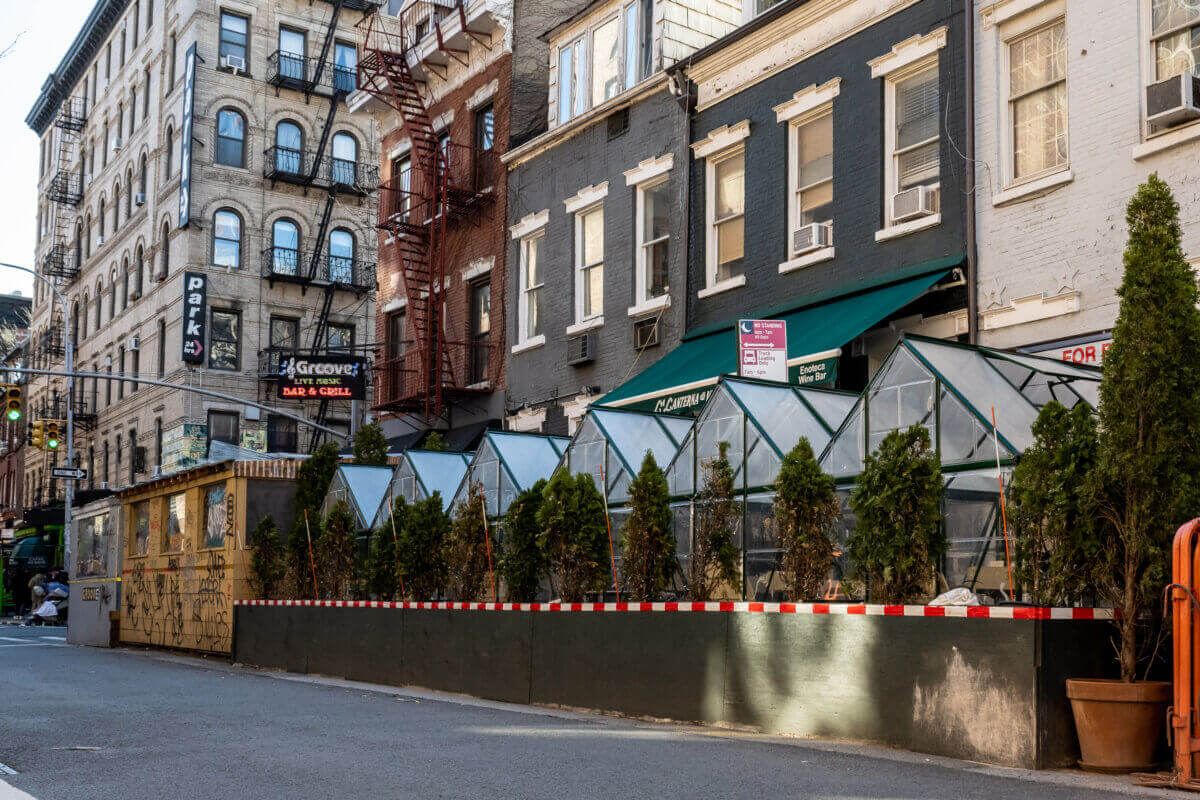
Prior to the pandemic, only about 1,000 restaurants across the boroughs had permits to operate a sidewalk cafe, and approximately 70 percent of them were in Manhattan. Today more than 12,800 cafes, bars, and restaurants use sidewalk and roadway space via the Open Restaurants program.
Outdoor dining is a program that most city lawmakers say is here to stay. However, the program remains temporary, and legislation needs to be passed for it to be permanent. And division remains among the public over whether it should remain in place at all.
Stuck in committee
A bill, which has the backing of Mayor Eric Adams, was introduced in the city council in February 2022 to make the program permanent. However, the intricacies of how it would work remain up in the air, with the legislation stuck in committee.
The proposal is a hot button issue, with its critics saying the pandemic is over and that it is time to get rid of the sheds and rein in the use of sidewalk dining.
“Take them down,” said Deborah Keir Dombrowski, a Bayside resident who was on the Bell Boulevard earlier this week. “They are an eyesore, and they create parking and traffic issues of every kind. They served their purpose. Time to move on.”
Meanwhile, restaurant advocates want the program to continue, although they recognize it needs to be tightly regulated with greater enforcement.
With the council wrestling with how to move forward, the program has been kept in place only by the mayor signing executive orders based on the emergency powers stemming from the Covid-19 epidemic.
Naysayers argue that the pandemic is over, and that the mayor is abusing his power by keeping the program in place.
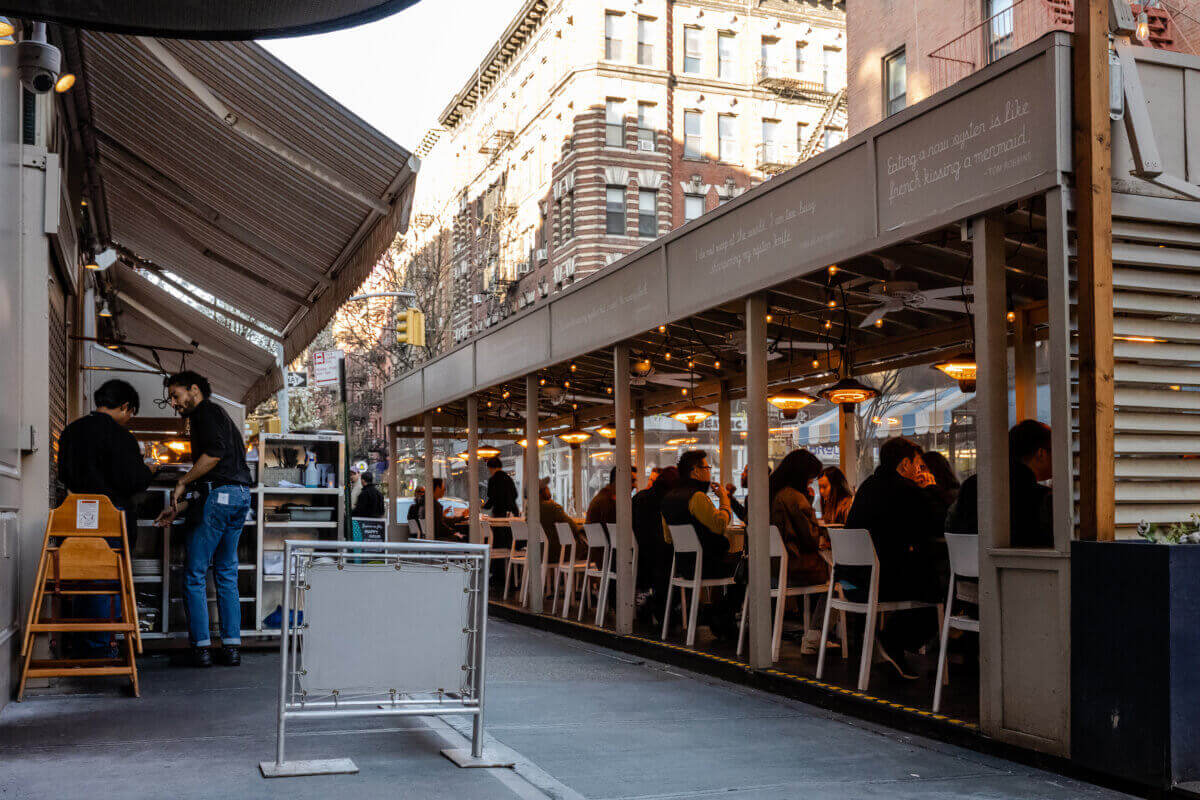
The mayor, according to a spokesperson for Adams, supports outdoor dining and plans to keep the temporary open restaurant program in place until a permanent program has been established. However, the mayor says improvements are needed to the program in its current form.
Last year, the city started removing abandoned sheds, starting with those belonging to restaurants that have permanently closed.
“Outdoor dining has transformed New York City…but we cannot allow abandoned dining sheds to litter our streets,” Adams said. “These deserted dining sheds have become eyesores for neighbors and havens for rats, and we are gong to tear them down.”
But the mayor insisted that outdoor dining is here to stay and that it is time for legislation to be agreed upon.
“It’s time to come together and figure out how New Yorkers can enjoy outdoor dining with a permanent version that works for business and residents,” the mayor said in his State of the City speech in January.
The legislation now stuck in the City Council would permit sidewalk dining to take place year round, but would prohibit roadway cafes from operating from November 1 through March 31 to keep the streets open during the late fall, winter, and early spring months.
All roadway cafes would need to be kept “open air,” rather than enclosed, the legislation further outlines. A governing body would also be created to develop the rules and regulations within the broad framework of the law.
Those rules would govern the dimensions and materials of the sheds as well as the sections of the sidewalk where they could be sited.
Much of the legislation is still being debated, but Andrew Rigie, executive director of the NYC Hospitality Alliance, anticipates that most of the roadway sheds will have to be torn down since they won’t comply with the new rules.
Who’s minding the stores?
The city’s Department of Consumer and Worker Protection, which oversaw the city’s sidewalk seating prior to the pandemic, would be put in charge of outdoor dining under the legislation. However, some lobbyists are advocating for it to fall under the city’s Department of Transportation, given roads are now being used. The DOT currently oversees the Open Restaurants program.
The supervisory body would determine the application process and govern how the program operates to ensure the general welfare of the public.
The legislation does spell out the a cost of a license. The operators of a sidewalk cafe would be charged, based on the current version of the bill, $510 for a two-year license period, while it would be $255 for a roadway shed. However, the restaurants also would be charged for using the public space –called consent fees — much like rent. The amount is yet to be determined.
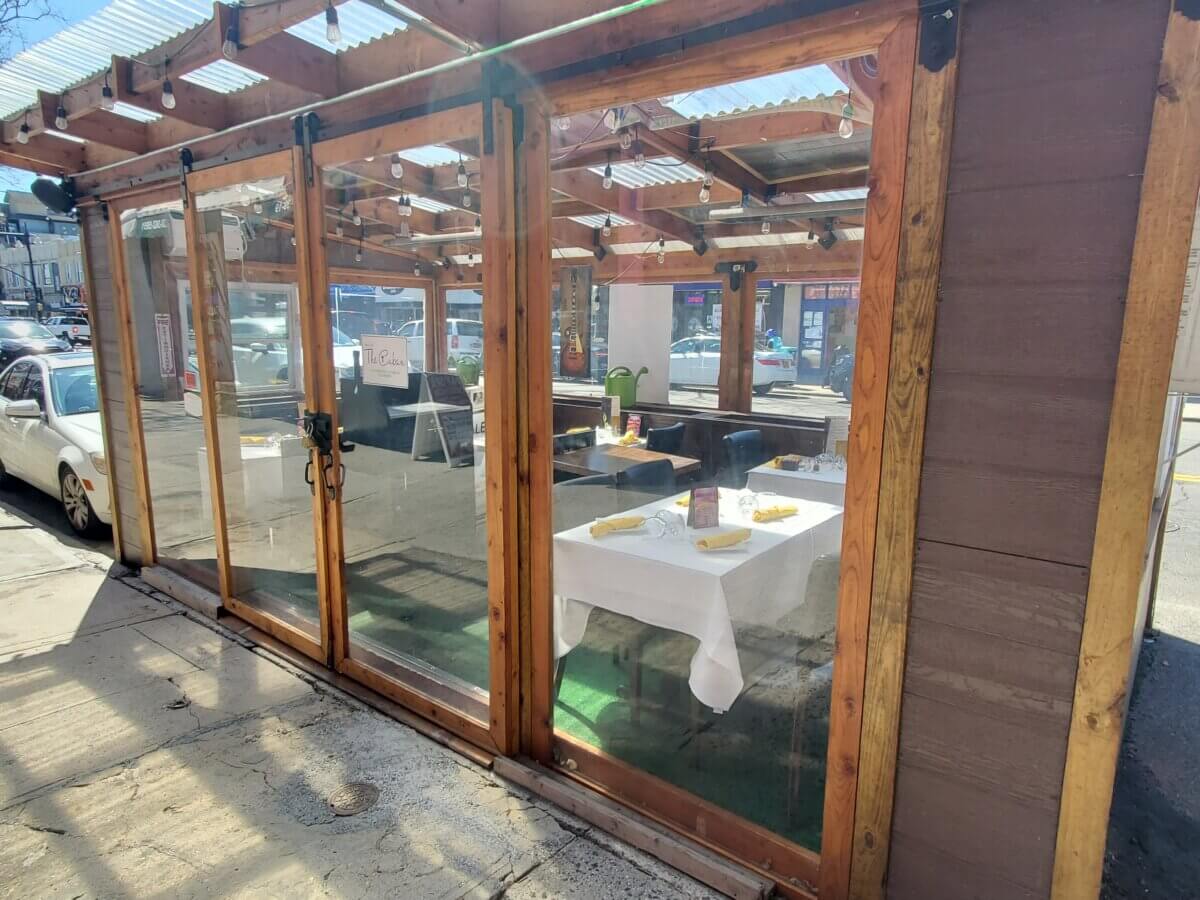
Community boards, under the legislation, would be notified when an application is filed and would be able to make a recommendation.
The supervisory body would also oversee enforcement and receive all complaints via 311 and other means.
The current bill, however, as written, remains a work in progress, according to a spokesperson for Council Speaker Adrienne Adams.
“Discussions with the administration and stakeholders are ongoing, and no bill has been finalized yet,” Speaker Adams said in a statement. “The council is continuing to work on a bill that creates a permanent outdoor dining program for the city that strikes the right balance for our restaurants, neighborhoods, and all New Yorkers.”
The uncertainty of the rules has left both the restaurant industry and residents in a state of limbo.
“Restaurants want to upgrade and invest in their outdoor dining,” Rigie said.
He said many roadside sheds were built quickly during the height of the pandemic and have taken a beating over the past three years and need to be upgraded. “But restaurateurs don’t want to spend money only to be told in the near future by the city that they will need to remove everything because it is no longer in compliance.”
Rigie said it is imperative that legislation is passed soon.
“The status quo is causing a lot of frustration for restaurateurs and residents. We are past the stage where we can continue operating like this, and people need certainty.”
Laying the foundation
The City Council, however, has taken one significant step toward putting in place a permanent plan.
The council passed a zoning bill in February 2022 that permits outdoor dining to take place in most commercial areas across New York City. Prior to the bill, outdoor dining was only permitted in a small section of New York City, mostly in Manhattan.
The Open Streets initiative has been a boon for the outer boroughs. Prior to its launch, only 30 percent of the approximately 1,000 restaurants with sidewalk licenses were located outside of Manhattan.
Today, 51 percent of the 12,000 open restaurants are found in the outer boroughs, according to a study of the Open Restaurants program released by New York University in December. Low-income and minority communities have also seen an influx of outdoor dining.
Prior to the pandemic, sidewalk cafes were only allowed in certain zoning districts, most of which were in Manhattan. Furthermore, roadway dining was also not permitted prior to the Open Streets initiative.
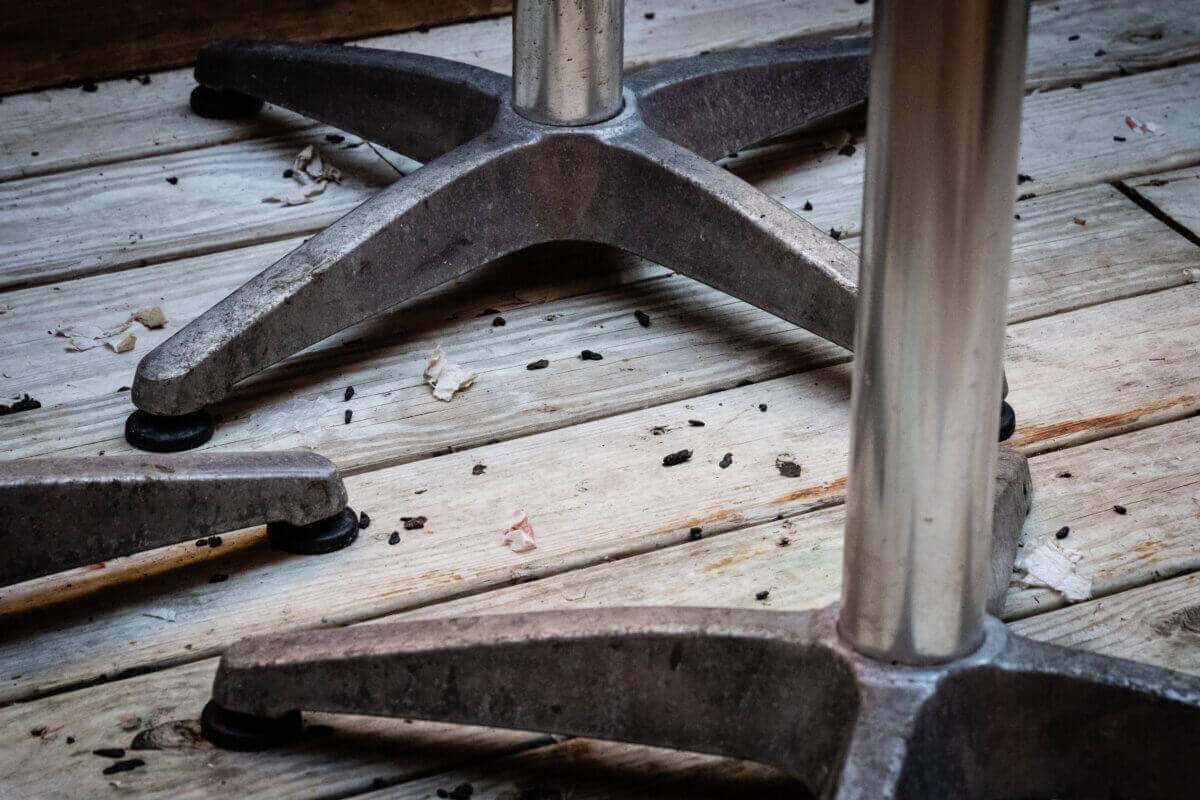
However, the zoning bill will only have an impact once permanent legislation dealing with outdoor dining is in place.
The restaurant industry is trying to shape how the legislation is crafted, advocating for the permanent program to be year round, low cost in terms of fees, and having a straightforward approval process.
Rigie said that the roadside dining needs to be year round since it is costly for restaurateurs to set them up only to take them down months later.
“It costs a lot of money to put one up on the roadway, and then there are challenges taking them down for colder months and finding a place to store them,” Rigie said. “This is particularly the case for smaller restaurants, which could put them out of reach for some.”
Rigie is also calling for the city to streamline the approval process for roadside sheds by coming up with pre-approved designs.
“We’d like to see the city pre-approve multiple design options that restaurants can select for the roadway, so they know they will be in compliance — and then they can customize it for their own look and own vibe,” he said. “We would also want an option where a restaurant could submit a true custom design for approval.”
‘Shed’-ding some light on the situation
Zander Nicastro, manager of the Beer Garage on Christopher Street in Manhattan, said restaurants should be allowed to maintain roadside dining all year round.
“It would be too much to take them up, put them down…,” Nicastro said. “If they stay up all year round, bars and restaurants will fix them up and do them up real nice. It would be better that just a temporary look.”
Leslie Clark, a member of the Coalition United for Equitable Urban Policy, an alliance of community-based associations opposed to roadside dining, said that roadside dining has led to filthy and congested streets that stink and are rat infested.
She said street sweeping has long been interrupted on streets with dining sheds. Some streets haven’t been properly cleaned by a Sanitation Department broom truck since the pandemic. She also said that in narrow streets with dining sheds, it can be difficult for emergency vehicles to get through.
Clark is urging the city council to hold public hearings across the city prior to the passage of any bill. Her group is calling for a seasonal sidewalk cafe program that covers the five boroughs.
She said any bill permitting roadway dining must require the restaurateur to take down their dining infrastructure each night. “You have to clean the streets,” she said.
Havens for rats?
Many sheds do attract rats.
Two employees of TATO Tex-Mex, a restaurant that recently opened on MacDougal Street in Greenwich Village, said they see rats coming out of the roadway sheds located on either side of their establishment.
The sheds, which belong to Monte’s Trattoria and Kati Roll, appear to be used for storage, with one of them covered in rat feces.
“There are a lot of rats that come out at night in those sheds,” one employee, who spoke on the condition of anonymity, said. “They have their little holes under the sheds.”
The employee pointed to the trash outside the restaurants. “You can see there’s a lot of garbage bags out there and they [the rats] tear them, so there’s a lot of garbage on the street.”
Noam Dworman, the owner of the Olive Tree and Comedy Cellar, said the sheds would be in much better condition if restaurant owners knew what the city’s plan for outdoor dining was.
“Nobody wants to invest a lot of money in making a beautiful shed if they think that in a few months they are going to have to take them down.”
He said the sooner the city makes the rules governing the sheds, the streets will be cleaner and there will be better materials. “People will invest in them.”
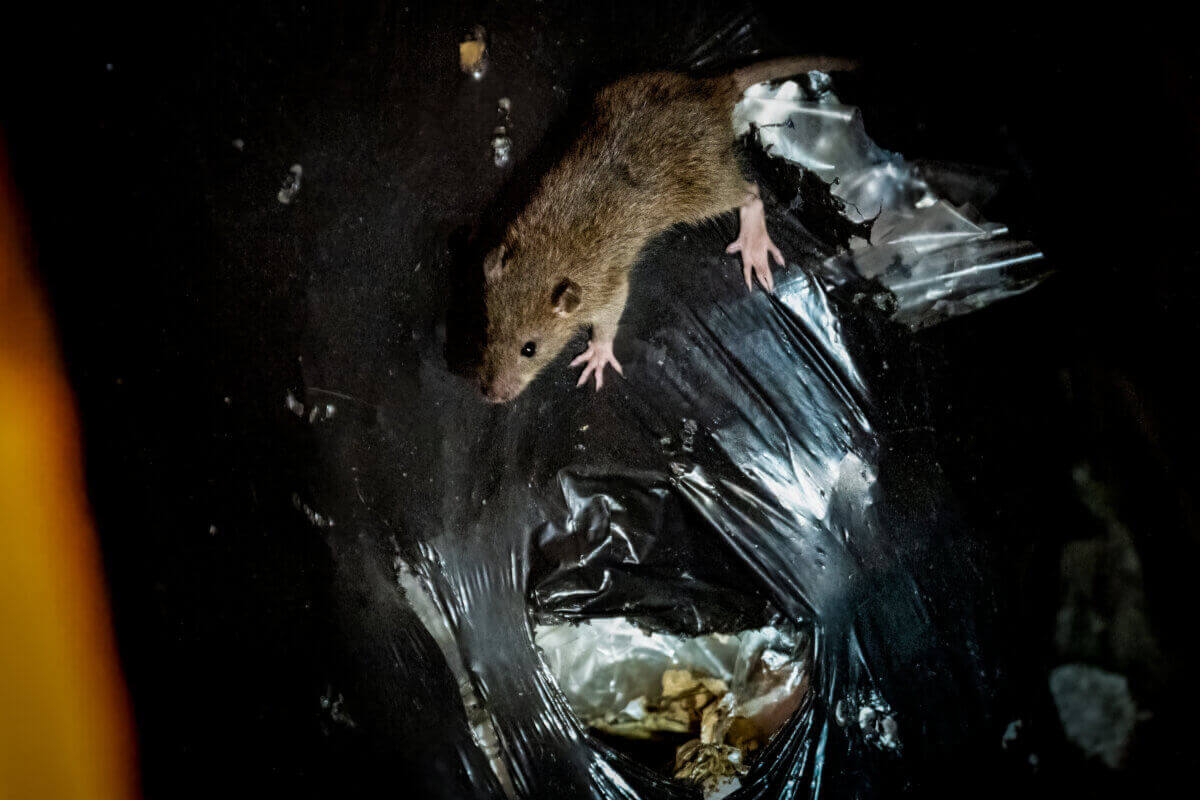
Dworman opined that the issue with rats is overblown and that they have always been a problem.
But the dilapidated sheds are unlikely to be torn down anytime soon.
The legislation, in its current form, would not go into effect for 180 days after it becomes law. Furthermore, restaurants would then have a year to apply for a permit.
Rigie said that many of the criticisms can be tackled when the supervisory body does the rule making.
“I think many of the concerns can be addressed through standardization, through design guidelines, and enforceable rules. I think a lot of these issues can be addressed.”
Furthermore, the rules could be made to ensure access for cleaning as well as define hours of operation.
Rigie also doesn’t want the program to be too expensive. Prior to the pandemic, the consent fees to operate a sidewalk seating area often cost tens of thousands of dollars per year, and that came after producing architectural plans and a six-month approval process.
Evan Franca, owner of BKLYN Crepe on Flatbush Avenue, said that outdoor dining has been a tremendous help to his business but he will only keep it if the city doesn’t charge too much.
“I love it but if they’re gonna charge us like $20,000 a year, it doesn’t make sense for us. But we hope it’s reasonable.”
Additional reporting by Ethan Marshall, Michael Dorgan, and Jada Camille; edited by Christian Murray and Robert Pozarycki
Editor’s note: A version of this story originally ran in amNY. Click here to see the original story.
Related Stories
- Bushwick’s Faro Restaurant Closing Its Doors After Eight Years
- Lenny’s Pizza of ‘Saturday Night Fever’ Fame Closes After 70 Years in Business
- Changing Outdoor Dining Guidelines Create a Challenge, Extra Costs for Restaurant Owners
Email tips@brownstoner.com with further comments, questions or tips. Follow Brownstoner on Twitter and Instagram, and like us on Facebook.








What's Your Take? Leave a Comment